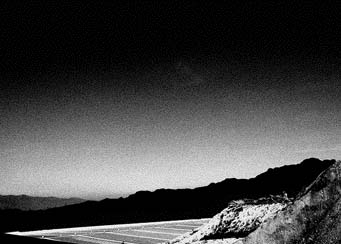Strange New World

There is an exhibition at the Museum of Contemporary Art in San Diego that I'd love to be able to go see right now. Strange New World is a vital celebration of the colorful urbanism of Tijuana that is straddling cultures, continents, and has become, as Dan Glaister describes in the Guardian, a post-modern icon for a collision of art, border culture, geopolitics, immigration and global capital.


The project has a sick-ass website, too, with lots of artist profiles, music, links, maps, packed with all sorts of nortec coolness. These first couple of images are from the navigation menus which scroll in wide hectic panaromas and maps of different clickable neighborhoods in the city.
Glaister writes: "Drive south on the I-5 freeway, past San Diego, through the scrap and scrub of Chula Vista and Palm City, and just a mile or two before the Mexican border at San Ysidro an unexpected sight looms off the far side of the road. It's a billboard, but what it is advertising is not clear. It shows the back of a man's head, his red neck showing through the gap between his cropped grey hair and camouflage T-shirt. The man gazes across the line. Before him lies the neatly levelled land on the US side of the border fence; beyond, to the south, is sprawl, chaos, uncertainty: Tijuana.

[...] Pull to the nearside lane and slow down to below the recommended freeway minimum speed and you may make out the legend written in the sky above the man's head: "Don't be a man for just a minute," it reads. "Be a man your whole life." And then it is gone. The journey south continues. The billboard is the work of Tijuana artist Marcos Ramírez, who works under the name Erre. The silver head belongs to one of the great theorists of southern California, Mike Davis."
The piece, from what I understand, was a response to a previous billboard that had appeared on the freeway going the opposite direction placed there by the Minutemen, which was sort of a warning to migrants and an advertisement for their vigalante group keeping tacky vigil over the grand border gate near San Ysidro.
"The black-and-white images - so grainy they could be painted on sand - show featureless structures marooned in the desert. They could be prison camps, they could be the border fence. But" Glasiter says, "they are the maquiladores." These are photos taken by my friend Sergio de la Torre who also produced the recent documentary Maquilapolis, which is an intense look at the rampant industry of assembly factories and a local activist movement there which has fought to reclaim their devastated community along the border.




For 'Manufactured Site', Teddy Cruz worked with several collaborators to develop the idea of a housing and mercantile development that could be mass-produced according to the tactics and strategies that are already informally used through out Tijuana.


As Cruz explains, “Conceived as a minimum gesture for maximum effect, this prefabricated frame acts as a hinge mechanism to mediate across the multiplicity of recycled materials and systems brought from San Diego and re-assembled in Tijuana.” The frame elements are infinitely flexile and could support a range of construction materials from corrugated metal to recycled tires and used palettes. Open to any number of means and ends, Cruz’s system aspires to more than mere construction – it hopes to build community.

'La region do los pantelones transfronterizos' (The Region of the Transborder Trousers), 2004-2005, marks the culmination of the ToroVestimienta project that concluded in 2004 after six seasons of production, a project which focused on clothing designed for border crossers. The project is also the fruition Torolab’s unique research methodology with which they transformed their use of clothing from billboard to a document of urban ethnography.

To make the piece, Torolab integrated global positioning systems into clothing designed for five individual subjects. For five days, as the participants moved through the Tijuana-San Diego region, Torolab tracked their location, velocity and fuel consumption. The resulting projection onto a topographic model of the region, synthesizes the collected data into elegant moving lines. The pulse, dimension, and speed of individual lines represent fluctuations in the data.


Also be sure to check out: inSite_05: Tijuana Calling; An Equator of Borderzones; WORLDVIEW: Tijuana: Mother of Invention; Welcome to America; The Immigrant, The Camp, and The NYSE; Migrant Structures; Rival Actions: at the border...; urban syntax: at the border...; Border CTRL; Borderville.







0 Comments:
Post a Comment
<< Home